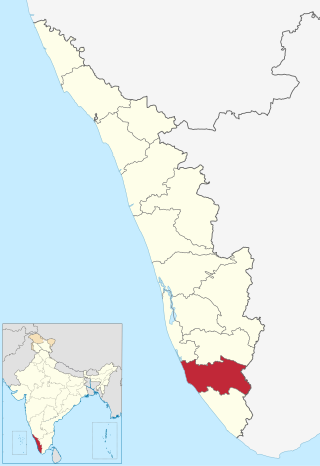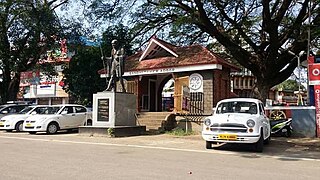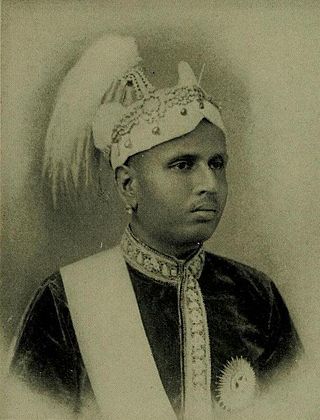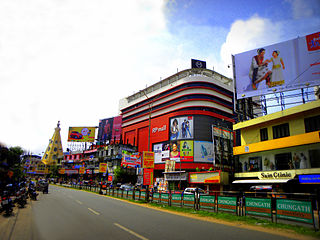Related Research Articles

The Kingdom of Travancore, also known as the Kingdom of Thiruvithamkoor, was an Indian kingdom from c. 1729 until 1949. It was ruled by the Travancore Royal Family from Padmanabhapuram, and later Thiruvananthapuram. At its zenith, the kingdom covered most of the south of modern-day Kerala and the southernmost part of modern-day Tamil Nadu with the Thachudaya Kaimal's enclave of Irinjalakuda Koodalmanikyam temple in the neighbouring Kingdom of Cochin. However Tangasseri area of Kollam city and Anchuthengu near Attingal in Thiruvananthapuram were parts of British India.

Kollam, also known by its former name Quilon, is an ancient seaport and city on the Malabar Coast of India bordering the Laccadive Sea, which is a part of the Arabian Sea. It is 71 km (44 mi) north of the state capital Thiruvananthapuram. The city is on the banks of Ashtamudi Lake and the Kallada river. Kollam is the fourth largest city in Kerala and is known for cashew processing and coir manufacturing. It is the southern gateway to the Backwaters of Kerala and is a prominent tourist destination. Kollam is one of the most historic cities with continuous settlements in India. Geographically, Quilon formation seen around coastal cliffs of Ashtamudi Lake, represent sediments laid down in the Kerala basin that existed during Mio-Pliocene times.

Kollam district, is one of 14 districts of the state of Kerala, India. The district has a cross-section of Kerala's natural attributes; it is endowed with a long coastline, a major Laccadive Sea seaport and an inland lake. The district has many water bodies. Kallada River is one among them, and land on the east bank of the river is East Kallada and that on the west bank is West Kallada.

Adoor is a municipality in the Pathanamthitta district of Kerala, India. It is the headquarters of the Adoor Taluk and Adoor Revenue Division. Adoor is located 13.2 km (8.2 mi) southwest of the district headquarters Pathanamthitta and 78.1 km (48.5 mi) north of the state capital Thiruvananthapuram.
The Thiruvananthapuram - Shoranur canal is a historic canal in India, from Trivandrum to Shoranur. It was one of the most arterial transportation mode in erstwhile Travancore princely state. Most of the trade, commerce and freight traffic in Travancore used to happen through this canal. The canal used to pass through rice bowl of the state, Kuttanad, centre of Coir trade i.e. Alappuzha, centre of Cashew business, Kollam, Changanassery market, strategic Thevally, Kayamkulam, Varkala etc. and used to connect Thiruvithamkoor with Cochin State and Malabar.

Sir Moolam Thirunal Rama Varma (1857–1924) was Maharajah of the princely state of Travancore between 1885 and 1924, succeeding his uncle Maharajah Visakham Thirunal (1880–1885). Moolam Thirunal is considered as the first in Indian to implement the concept of public participation in governance through the formation of Travancore Legislative Council.

The Ministry of Textiles is an Indian government national agency responsible for the formulation of policy, planning, development, export promotion and regulation of the textile industry in India. This includes all natural, artificial, and cellulosic fibers that go into the making of textiles, clothing and Handicrafts.

Girangaon was a name of an area now part of central Mumbai, India, which at one time had almost 130 textile mills, with the majority being cotton mills. The mills of Girangaon contributed significantly to the prosperity and growth of Mumbai during the later nineteenth century and for the transformation of Mumbai into a major industrial metropolis. Girangaon covered an area of 600 acres (2.4 km2), not including the workers' housing. The mill workers lived in a community, and they fostered a unique culture which shaped Mumbai at the turn of the twentieth century. This textile industry flourished until the early 2000s after which most of the mills were shut down, as the owners deemed them unprofitable and declared they were incapable of paying their workers' wages.
National Textile Corporation is a central public sector undertaking under the ownership of Ministry of Textiles, Government of India. It owns 23 working textile mills which produce yarn and fabric. The company was incorporated in April 1968.
Azam Jahi Mills is a company established in Warangal district of the Kingdom of Hyderabad. Azam Jahi Mills was established by the 7th Nizam of Hyderabad Mir Osman Ali Khan in 1934 and is named after his 1st son - Prince Azam Jah.

Arvind Limited is an Indian textile manufacturer and the flagship company of the Lalbhai Group. Its headquarters are in Naroda, Ahmedabad, Gujarat, India, and it has units at Santej. The company manufactures cotton shirting, denim, knits and bottomweight (khaki) fabrics. It has also recently ventured into technical textiles with its Advanced Materials Division in 2011. It is India's largest denim manufacturer.

Kollam Bypass is a part of NH 66 that bypasses CBD of Kollam city in Kerala, India. The busy 13.141 km long bypass starts at Mevaram in the south to Kavanad in the north, via Ayathil, Kallumthazham, Kadavoor and Kureepuzha in Kollam city. It is a joint venture between the central and state government. It was inaugurated on 15 January 2019 by Prime Minister Narendra Modi.

Kollam Municipal Corporation (KMC) is an ISO 9001:2015 certified civic body that governs the city of Kollam in the Indian state of Kerala. It is the fourth-largest city corporation by population in the state, and the fifth-largest by area. Constituted in 1903 it was officially recognized as a city corporation in 2000. The body governs an area of 73.03 square kilometres (28.20 sq mi) centered at Kollam, with about 55 divisions and a population of 397,419.

Government Medical College, Kollam, formerly ESIC Medical College, Parippally, is the first Government medical college in Kollam district, Kerala, India. It is situated 21 km (13 mi) south of Kollam city and 9.6 km (6.0 mi) east of Paravur town. The College was initially established by the Employees State Insurance Corporation, a Government of India establishment, and later acquired by the Government of Kerala.

Mevaram, is a neighbourhood and a junction in the city of Kollam in the Indian state of Kerala. The Kollam Bypass, which forms part of National Highway-66, begins from Mevaram junction. Mevaram is located at the borders of Kollam Municipal Corporation. It is the southern tip of Kollam City.

Kollam or Quilon is an old seaport and a city on the Laccadive Sea coast in Kerala, India, on Ashtamudi Lake. The city remains notable as the ancient commercial capital of Kerala and the southwestern Indian coast, in addition to its fame as the "Cashew Capital of the World". The Kollam Municipal Corporation has the second largest budget in Kerala in terms of revenue and expenditure.

Ayathil is a neighbourhood in Vadakkevila zone of Kollam city, Kerala, India. It is the 36th ward in Kollam Municipal Corporation. It is one of the cashew processing hubs in Kollam city. Kerala State Cashew Development Corporation Limited has a factory there. Kollam Bypass passes through Ayathil.

Quilon or Coulão, officially Kollam is one of the ancient civilizations in India.It is one of the oldest port cities in the Malabar Coast and was the capital city of historic Venad Kingdom and Travancore Kingdom. Quilon was once an important trading port in India. It was also known as Desinganadu. It is now known as the "Cashew Capital of the World".
Tata Textile Mills was a textile mills business of Tata Group, with its head office in Bombay. It consisted of four textile mills; namely, Central India Mills also popularly known as Empress Mills in Nagpur, the Svadeshi Mills in Bombay, the Tata Mills in Bombay, and the Advance Mills in Ahmedabad. For several decades the four mills produced and sold fabrics under the much-reputed brand name of Tata Textiles.
Sick Textile Undertakings (Nationalization) Act 1974 is the law enacted by parliament of India in December 1974 to acquire sick textile units, reorganise and rehabilitate them to "subserve the interests of the general public by the augmentation of the production and distribution, at fair prices, of different varieties of cloth and yarn".
References
- ↑ Special Correspondent. "People demand cotton Mills land for MCH". The Hindu. Retrieved 25 February 2015.
- 1 2 3 Staff Reporter. "Fresh moves to revive Parvathy Mills in Kollam". The Hindu. Retrieved 25 February 2015.
- ↑ "District Official Telephone Numbers – Kollam" . Retrieved 24 February 2015.
- 1 2 3 "Delay in identifying land holds up Kollam medical college plan". Deccan Chronicle. Retrieved 24 February 2015.
- ↑ "Drop moves to privatise Parvathy Mills". The Hindu . 22 November 2005. Archived from the original on 24 February 2015. Retrieved 24 February 2015.
- ↑ "NTC set to cash in on hot properties". The Economic Times. Retrieved 24 February 2015.
- ↑ "Parvathy Mills may get modernised". TNIE. Archived from the original on 24 February 2015. Retrieved 24 February 2015.
- ↑ "People demand Parvathi Mills land for MCH". The Hindu. Retrieved 24 February 2015.
- ↑ "Thiruvananthapuram: No work, full pay at National Textile Corporation". Deccan Chronicle. 20 November 2019. Retrieved 20 November 2019.